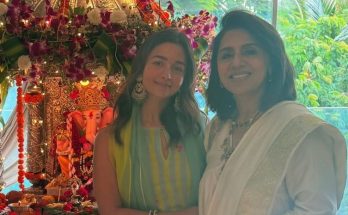By Sujoy Dhar
#Dharmendra# He-Man of Bollywood# Veeru# Bollywood legend# Bollywood actor# Indian Cinema# Sholay# Bollywood hero# Dharmendra biography# Bollywood icon# Bollywood star# Hindi cinema# Dharmendra films# Bollywood nostalgia# legendary actors
IBNS-CMEDIA: One of the most beloved stories from the sets of Sholay comes from the shooting of the iconic “Basanti, in kutton ke saamne mat naachna!” scene. The story goes that Dharmendra—already adored for his charm—kept insisting on multiple retakes, claiming he wasn’t satisfied with his delivery.
The truth, the crew later joked, was far more romantic: he simply wanted Hema Malini, who played Basanti and whom he was secretly wooing at the time, to remain on set a little longer.
Ramesh Sippy reportedly teased him, saying, “Dharam, at this rate the film will finish, but you’ll still be doing this shot!” Dharmendra just laughed, flashed that irresistible Veeru grin, and said, “Arre, perfect shot chahiye, boss!”
What the crew saw that day wasn’t just an actor chasing perfection—it was the effortless transformation of Dharmendra into Veeru, the happy-go-lucky romantic hero whose boyish charm made Sholay sparkle with warmth even amidst its violence.
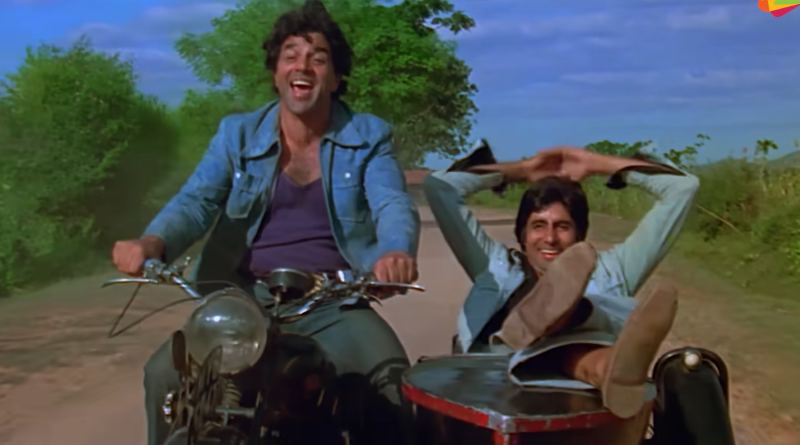 Dharmendra and Amitabh Bachchan in Sholay.
Dharmendra and Amitabh Bachchan in Sholay.
That mix of mischief, masculinity, and emotion became the essence of Veeru, and one of the reasons the character lives on as one of the most iconic in Indian cinema.
On Nov 24, 2025, India’s film industry bid goodbye to this legend as Dharmendra passed away at the age of 89 in his Juhu home in Mumbai. Reports say his health had been precarious in recent weeks following a hospital stay, and his passing marks the end of an era.
The OG hunk of Bollywood
From his first stride across the screen in humble rural attire to the rugged swagger that made him Bollywood’s original action icon, Dharmendra embodied a rare mix of raw charisma and unshakable professionalism.
He was the kind of actor who once paused a fight scene under scorching lights to insist on perfection—not because he feared mistakes, but because he revered his craft.
 Dharmendra in Seeta Aur Geeta.
Dharmendra in Seeta Aur Geeta.
Even in his prime, his chiseled physique and magnetically handsome features turned him into Hindi cinema’s “He-Man.” Coupled with an impressive dedication to his roles, Dharmendra’s performances crackled with a potent energy that delighted audiences for decades.
A titan’s six-decade Journey
Born Dharmendra Kewal Krishan Deol on 8 December 1935 in Ludhiana, Punjab, his journey from village to the silver screen is the stuff of Bollywood lore. He debuted in 1960 with the romantic drama Dil Bhi Tera Hum Bhi Tere, but it was his performance in Haqeeqat (1964), a war film set against the backdrop of the Sino-Indian conflict, that first showcased his emotional range and fearless intensity.
He truly announced himself with Phool Aur Patthar (1966), where the contrast between his soft-spoken romantic side and raw screen power made him an instant heartthrob. His superstardom crystallised with Phool Aur Patthar and nuanced performance as a hardened criminal won hearts and earned him his first Filmfare nomination for Best Actor.
By the early 70s, he was winning over audiences in films like Mera Gaon Mera Desh (1971), a rural action drama beloved for its patriotic fervor and Dharmendra’s rugged charm.
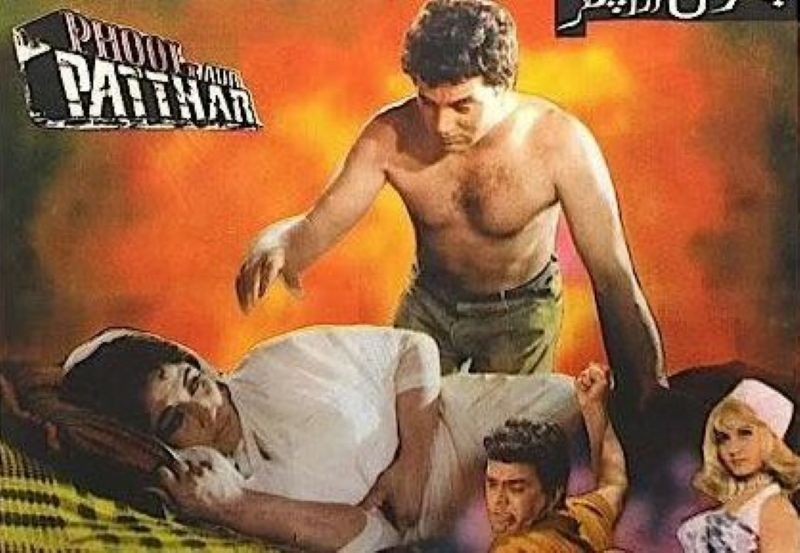 When Dharmendra went shirtless in Phool Aur Patthar. The iconic poster.
When Dharmendra went shirtless in Phool Aur Patthar. The iconic poster.
His versatility shone in classics such as Seeta Aur Geeta (1972), where he balanced action with comedy and Chupke Chupke (1975), a lighthearted romantic comedy that remains a fan favorite. By then, he had cemented his place in Bollywood’s pantheon. But it was his role in Sholay (1975), as the irrepressible Veeru, that immortalized him — his chemistry with Amitabh Bachchan and his fearless bravado became the stuff of cinematic legend.
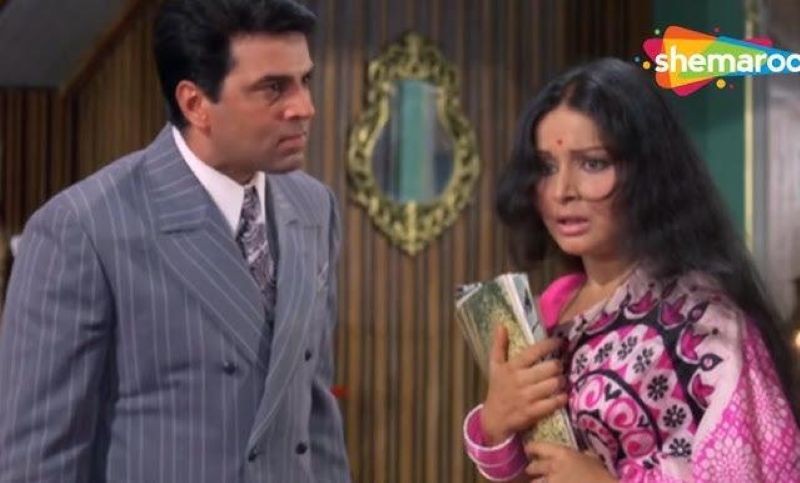 Dharmendra with Raakhee Gulzar in Blackmail. Photo: YouTube Screenshot
Dharmendra with Raakhee Gulzar in Blackmail. Photo: YouTube Screenshot
Dharmendra delivered one of his most nuanced performances in Blackmail (1973), playing an engineer whose life spirals into chaos after he uncovers a dangerous secret. Opposite him, Raakhee brought quiet strength and emotional depth to her role, creating a compelling dynamic that drives the film’s tension. Their on-screen pairing added both warmth and suspense to Vijay Anand’s taut narrative, making Blackmail a memorable blend of romance, intrigue, and psychological drama.
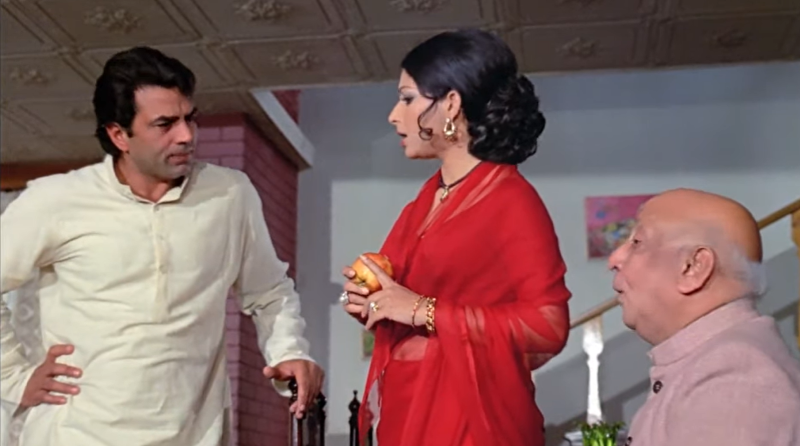 Dharmendra with Sharmila Tagore in Chupke Chupke.
Dharmendra with Sharmila Tagore in Chupke Chupke.
Dharmendra’s cinematic legacy thus stretches across 300-plus films over more than six decades, a feat matched by very few in Hindi cinema.
Dharam-Hema Pair
Few on-screen pairings in Hindi cinema have enjoyed the enduring magic of Dharmendra and Hema Malini. Together, they created sparks in over 40 films, spanning romance, comedy, drama, and action—each performance adding to their reputation as one of Bollywood’s most iconic duos.
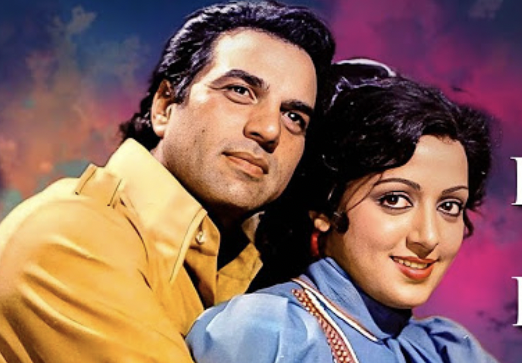 Together, Dharmendra and Hema created sparks in over 40 films. Photo: YouTube Screenshot
Together, Dharmendra and Hema created sparks in over 40 films. Photo: YouTube Screenshot
Their chemistry first drew widespread attention in Tum Haseen Main Jawaan (1970), and from there they went on to deliver a string of memorable hits including Seeta Aur Geeta (1972), Sharafat (1970), Naya Zamana (1971), Jugnu (1973), Dost (1974), and of course Sholay (1975), where their playful banter as Basanti and Veeru became part of Bollywood folklore.
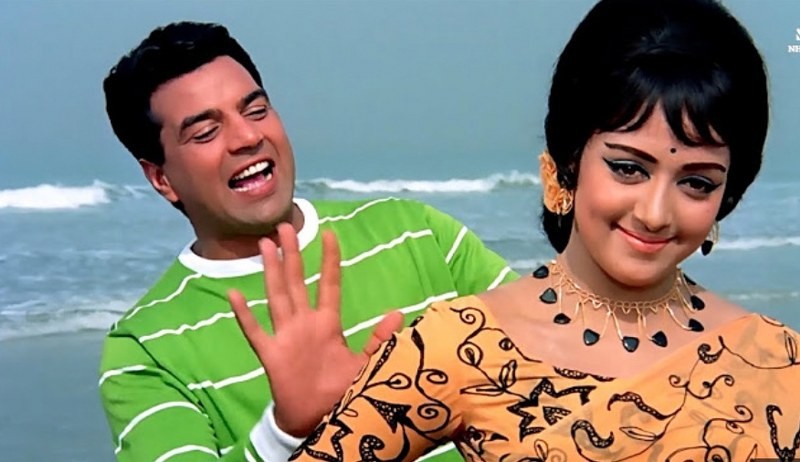 Dharam and Hema in a scene from Tum Haseen Main Jawaan. Photo: YouTube Screenshot
Dharam and Hema in a scene from Tum Haseen Main Jawaan. Photo: YouTube Screenshot
Dharmendra continued to headline major commercial films throughout the ’80s and early ’90s, commanding loyal audiences across generations. In Baghavat (1982), he embraced a classic action-adventure set in a royal backdrop, demonstrating his enduring popularity as a swashbuckling hero. The later decade saw him in mass entertainers like Dadagiri (1987), where his trademark alpha-hero energy resonated strongly with small-town audiences.
Even as cinema evolved, he remained a familiar face in films such as Khule-Aam (1992), reflecting both his longevity and the industry’s continued faith in his star power. Together, these films—and hundreds more—form a tapestry of one of the richest, most diverse careers in Indian film history.
He also proved his staying power through later decades, transitioning into character roles and working alongside his sons in the Yamla Pagla Deewana films, in Karan Johar’s Rocky Aur Rani Kii Prem Kahaani (opposite Shabana Azmi) and his final appearance will be in Ikkis, slated for release in December 2025
The man beyond the screen
Dharmendra’s personal life was as storied as his on-screen journey, marked by two marriages that shaped a sprawling, multigenerational film family. He first married Prakash Kaur in 1954, with whom he had four children—Sunny Deol and Bobby Deol, both of whom rose to become acclaimed Bollywood actors, and Vijayta and Ajeeta, who chose largely private lives away from the spotlight.
Later, in the 1970s, Dharmendra married Hema Malini, his Sholay co-star and heroine of umpteen films, in a union that became one of Bollywood’s most talked-about love stories. Together, they had two daughters—Esha Deol, an actor who made her mark in the 2000s, and Ahana Deol, a classical dancer and choreographer.
Despite the complexities of his dual family life, Dharmendra remained a deeply affectionate patriarch whose legacy continues through the artistic paths of his children and grandchildren.
 Dharmendra with his actor sons, Sunny Deol and Bobby Deol, in Yamla Pagla Deewana.
Dharmendra with his actor sons, Sunny Deol and Bobby Deol, in Yamla Pagla Deewana.
He was famously candid about his journey—he once revealed that, for years, he stitched his own suits, patiently saving for recognition he believed his body of work deserved. Later in life, he embraced a simple, organic lifestyle: tending to his farm, driving his tractor, and dispensing gentle wisdom with the same ease he once delivered fiery dialogues.
In recognition of his monumental contribution to Indian cinema, Dharmendra was honored with the Padma Bhushanin 2012. He also ventured into politics, serving as a Member of Parliament representing Bikaner for the Bharatiya Janata Party.
When Dharmendra found solace in Meena Kumari
Dharmendra’s early years in the industry were also marked by a much-discussed romance with Meena Kumari, the legendary tragedienne of Hindi cinema. Their relationship blossomed during the filming of Phool Aur Patthar (1966), the movie that first transformed Dharmendra into a bona fide star.
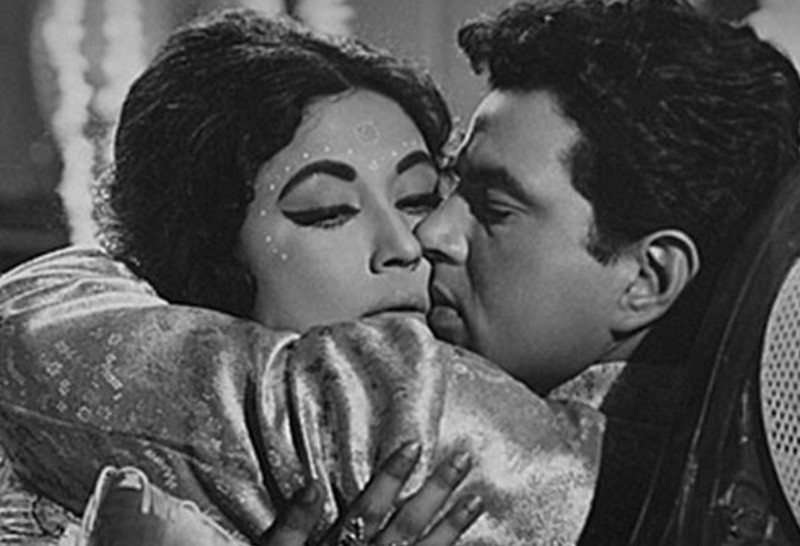 Meena Kumari supposedly played a pivotal role in shaping Dharmendra’s career and acting. Photo: YouTube
Meena Kumari supposedly played a pivotal role in shaping Dharmendra’s career and acting. Photo: YouTube
While Meena Kumari was already an established icon battling personal turmoil, Dharmendra was a rising actor drawn to her grace, melancholy, and unmatched artistry. Their bond, though brief and complicated, became one of Bollywood’s most whispered-about liaisons—tender, intense, and inevitably transient.
Many film historians believe that Meena Kumari played a quiet but pivotal role in shaping Dharmendra’s refinement as an actor, encouraging him during a crucial stage of his career. Their relationship eventually faded, but it remains a poignant footnote in the intertwined histories of two of Indian cinema’s most luminous personalities.
More than a Hero
What truly made Dharmendra unforgettable wasn’t just his smoldering looks or his action hero persona—it was his heart. Audiences loved him for his swagger, but they respected him for his humility.
Colleagues praised his work ethic; fans admired his staying power. As one industry veteran said, he carried Bollywood on his broad shoulders, but never forgot his roots.
As the film world mourns his passing, it’s his laughter, generosity, and resilience that will be equally missed. He wasn’t just Bollywood’s He-Man—he was its gentle giant, its action hero, and its soulful romantic all rolled into one.
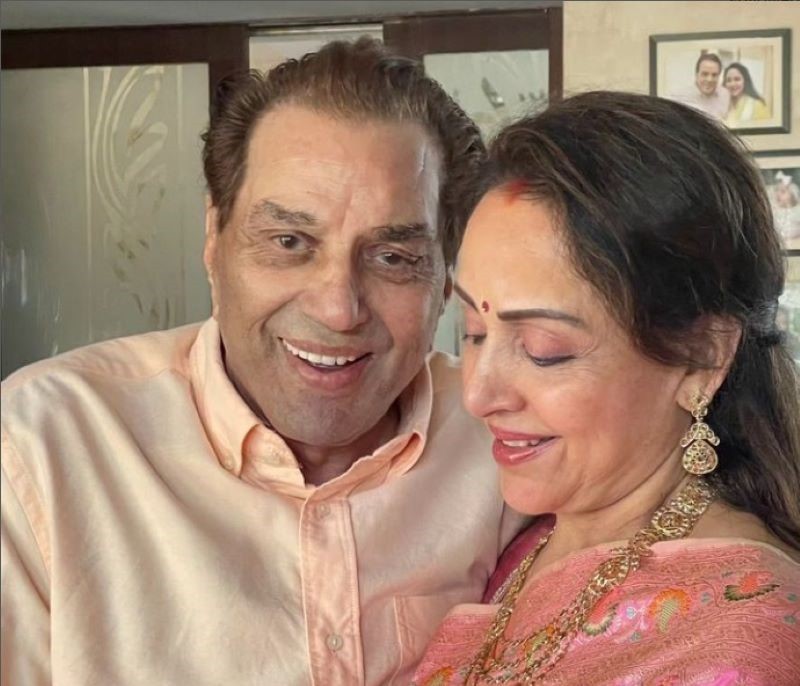 Hema Malini with Dharmendra. Photo: Official Instagram.
Hema Malini with Dharmendra. Photo: Official Instagram.
(Photos: Screen-grab/YouTube and Dharmendra/Facebook)



